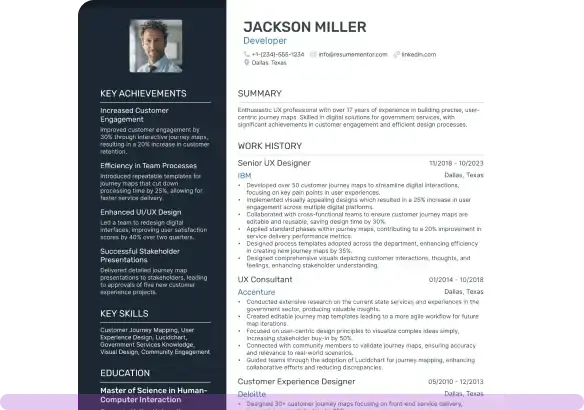One Page Resume Examples

Mar 26, 2025
|
12 min read
Craft a stand-out one page resume with our comprehensive guide. Discover top tips to highlight your skills and land your dream job. Tackle the job hunt with precision and avoid getting "resumed" to the discard pile.
Rated by 348 people
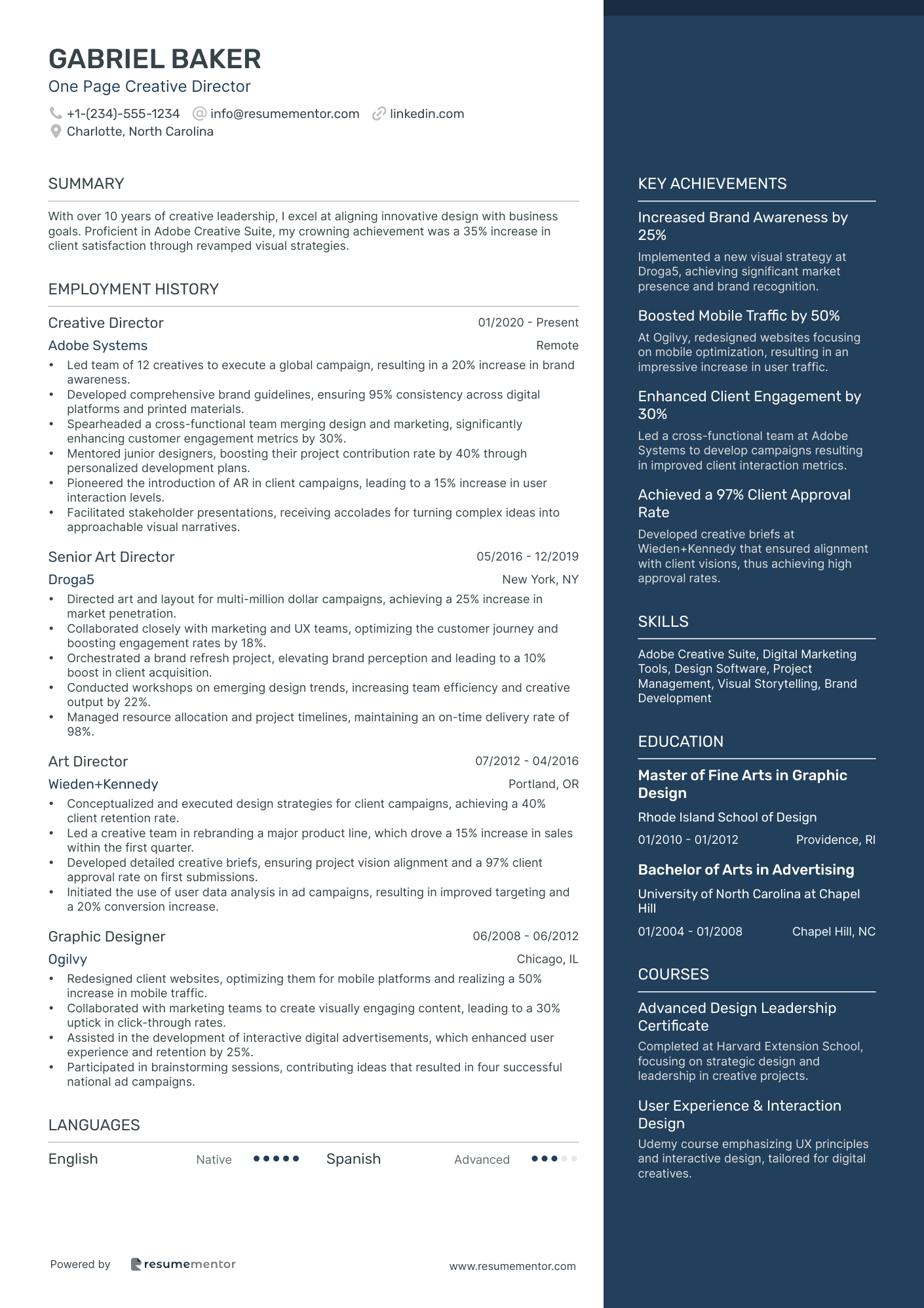
One Page Creative Director
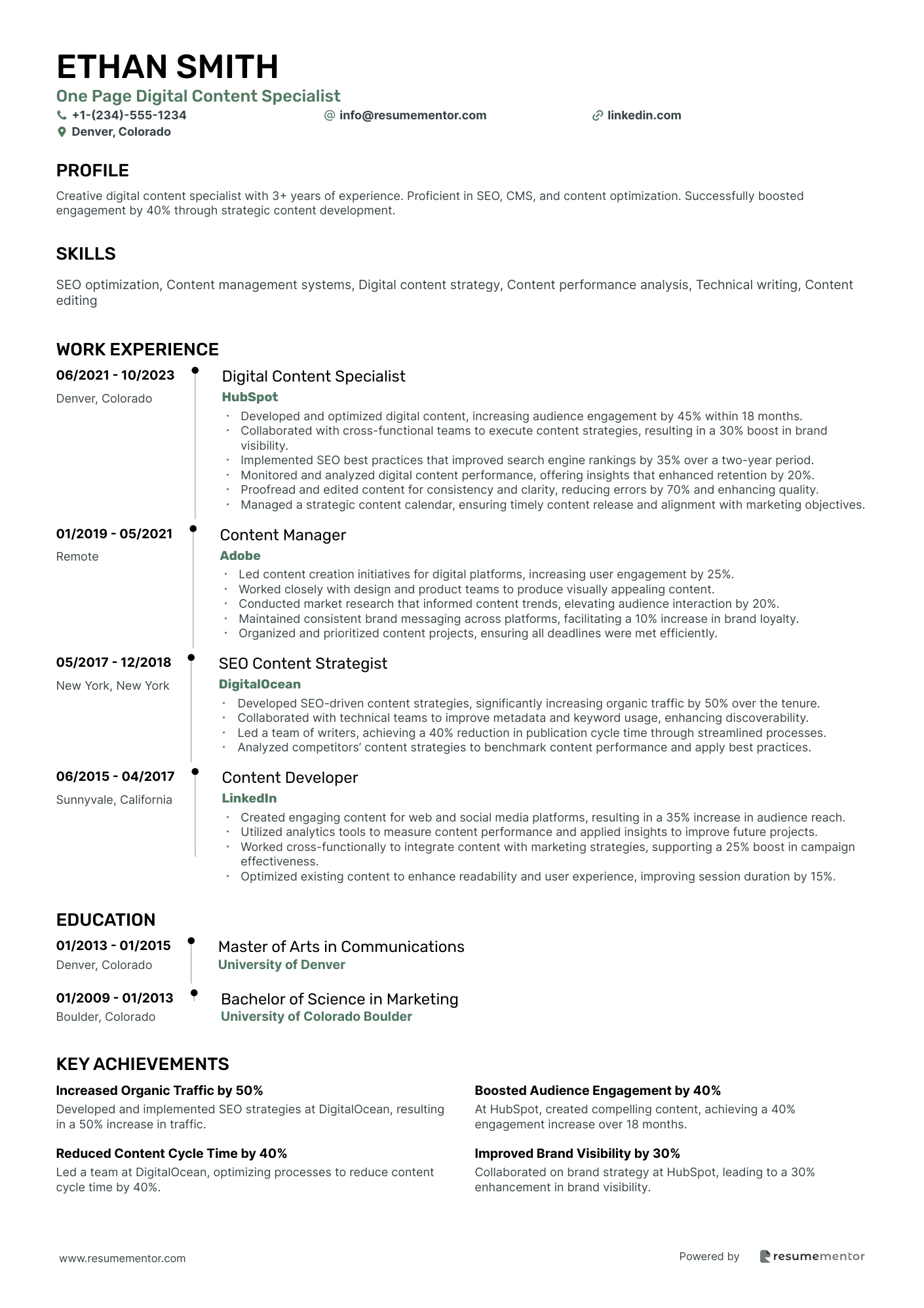
One Page Digital Content Specialist
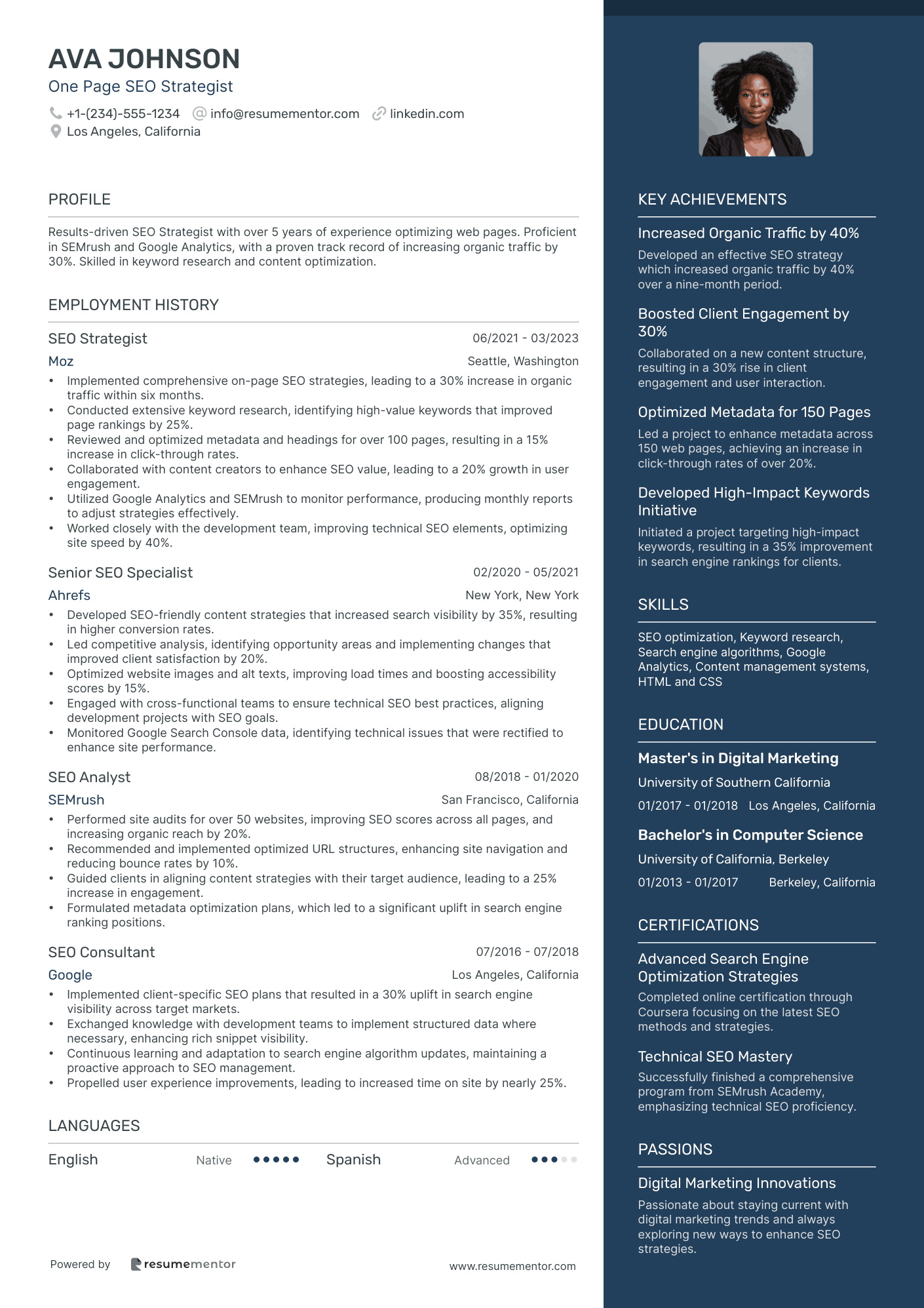
One Page SEO Strategist

One Page UX Designer
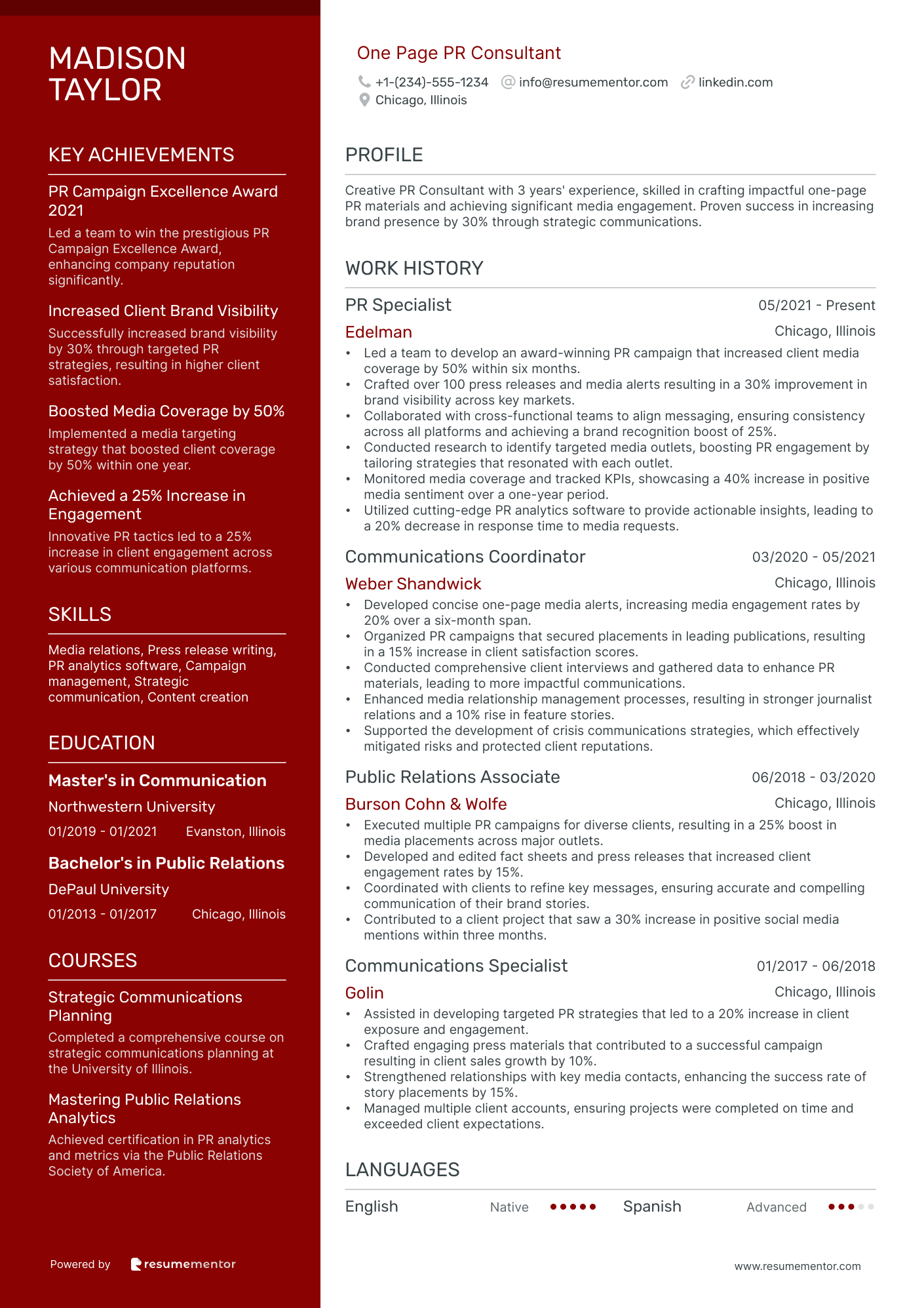
One Page PR Consultant
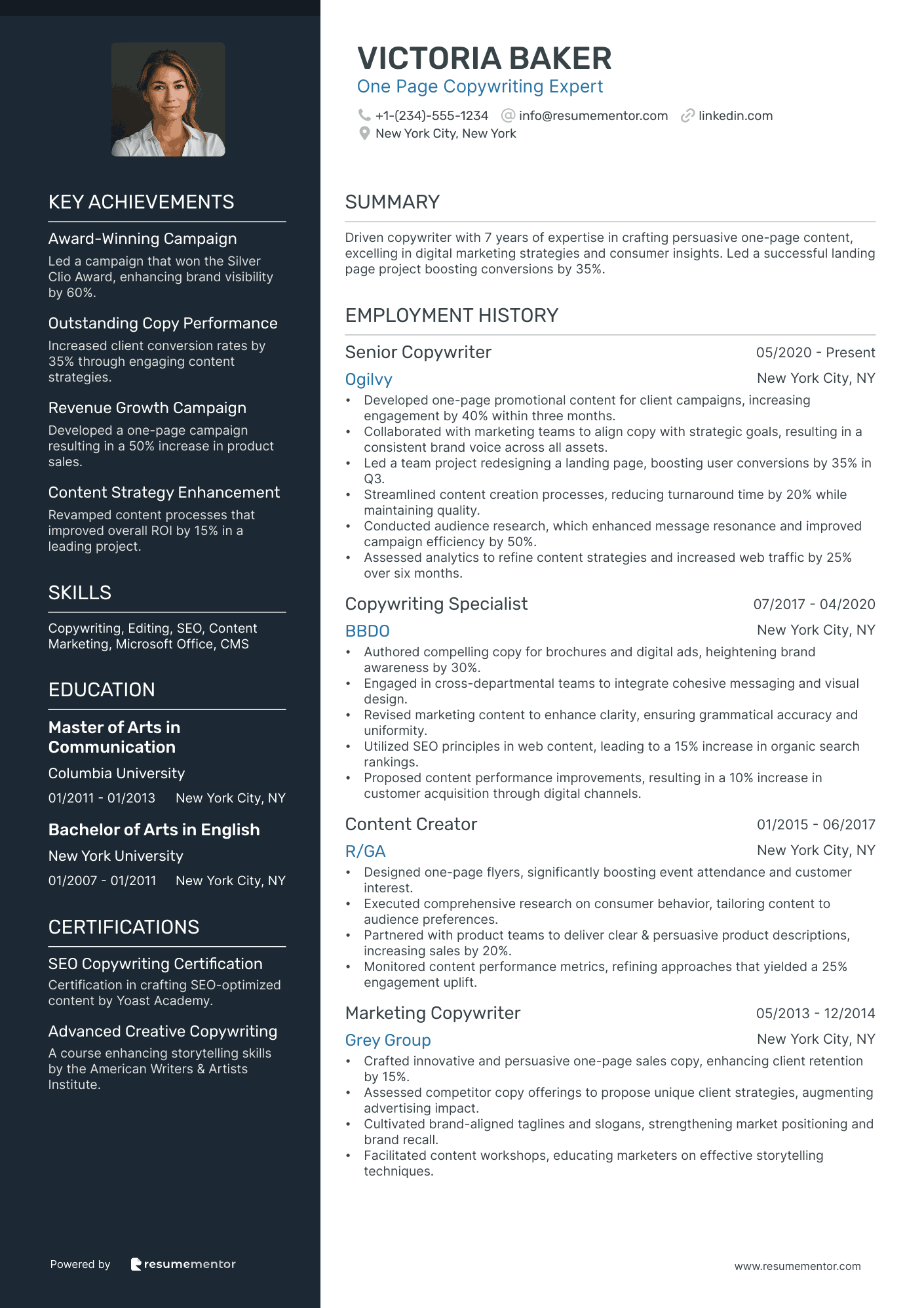
One Page Copywriting Expert
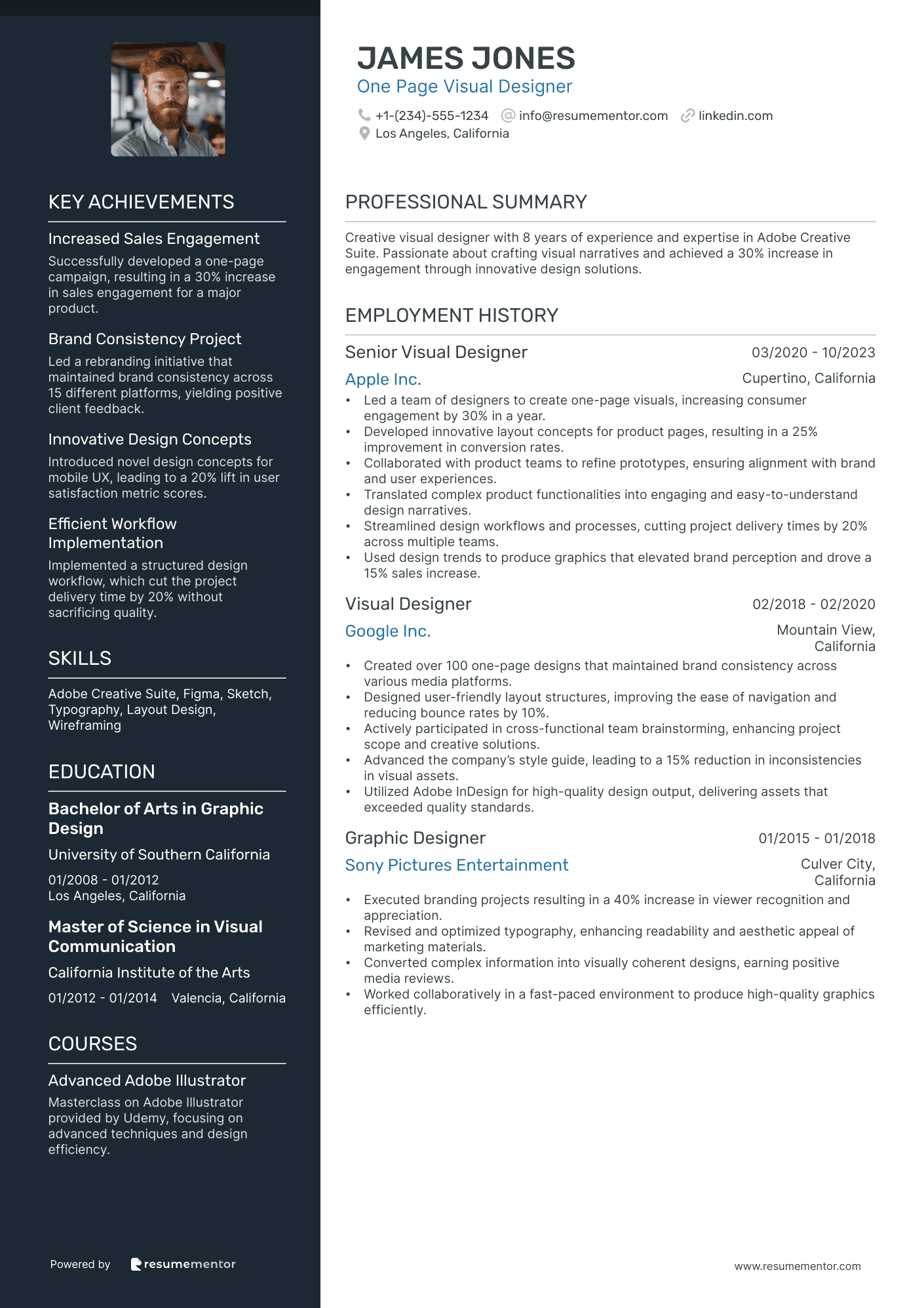
One Page Visual Designer
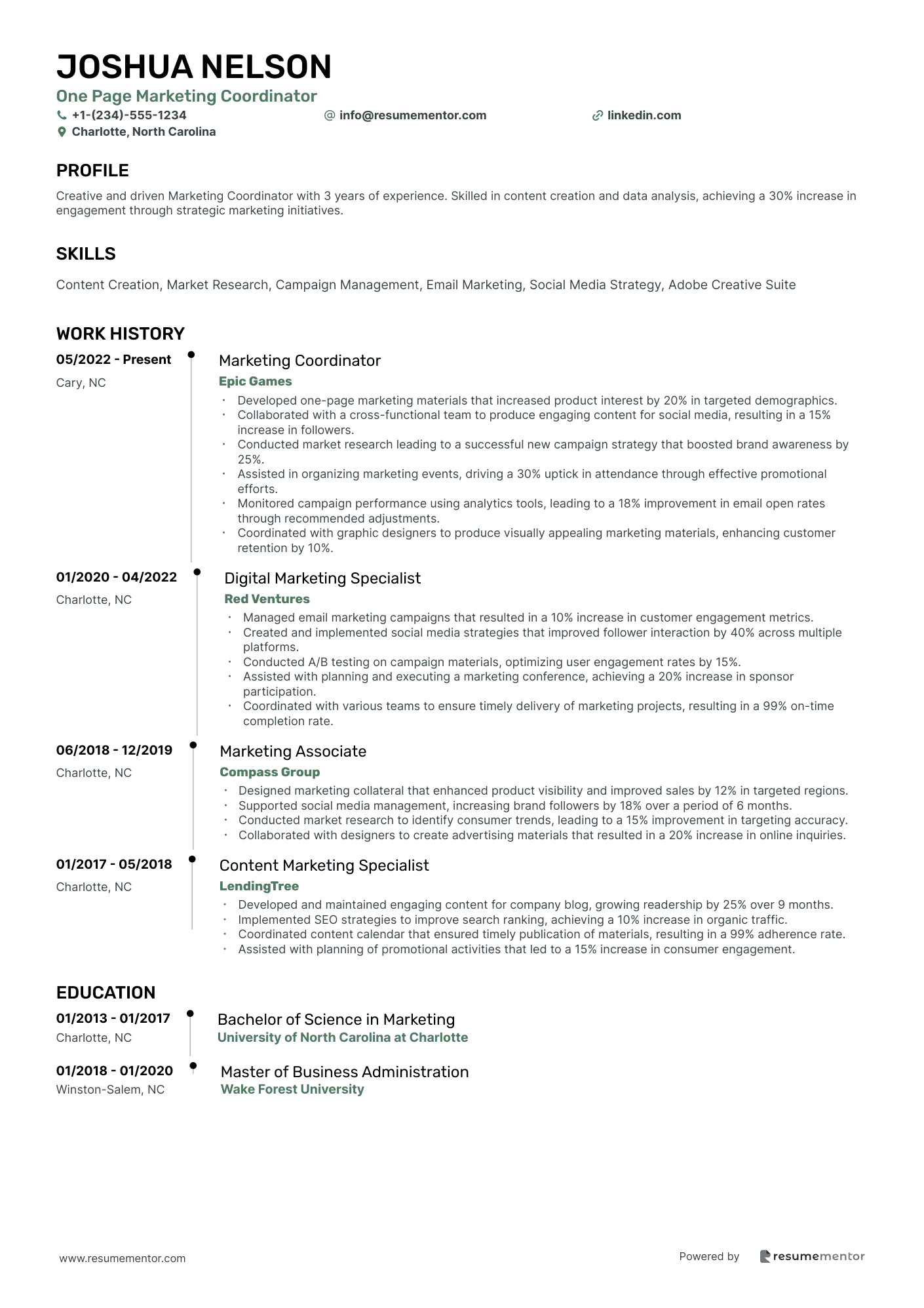
One Page Marketing Coordinator
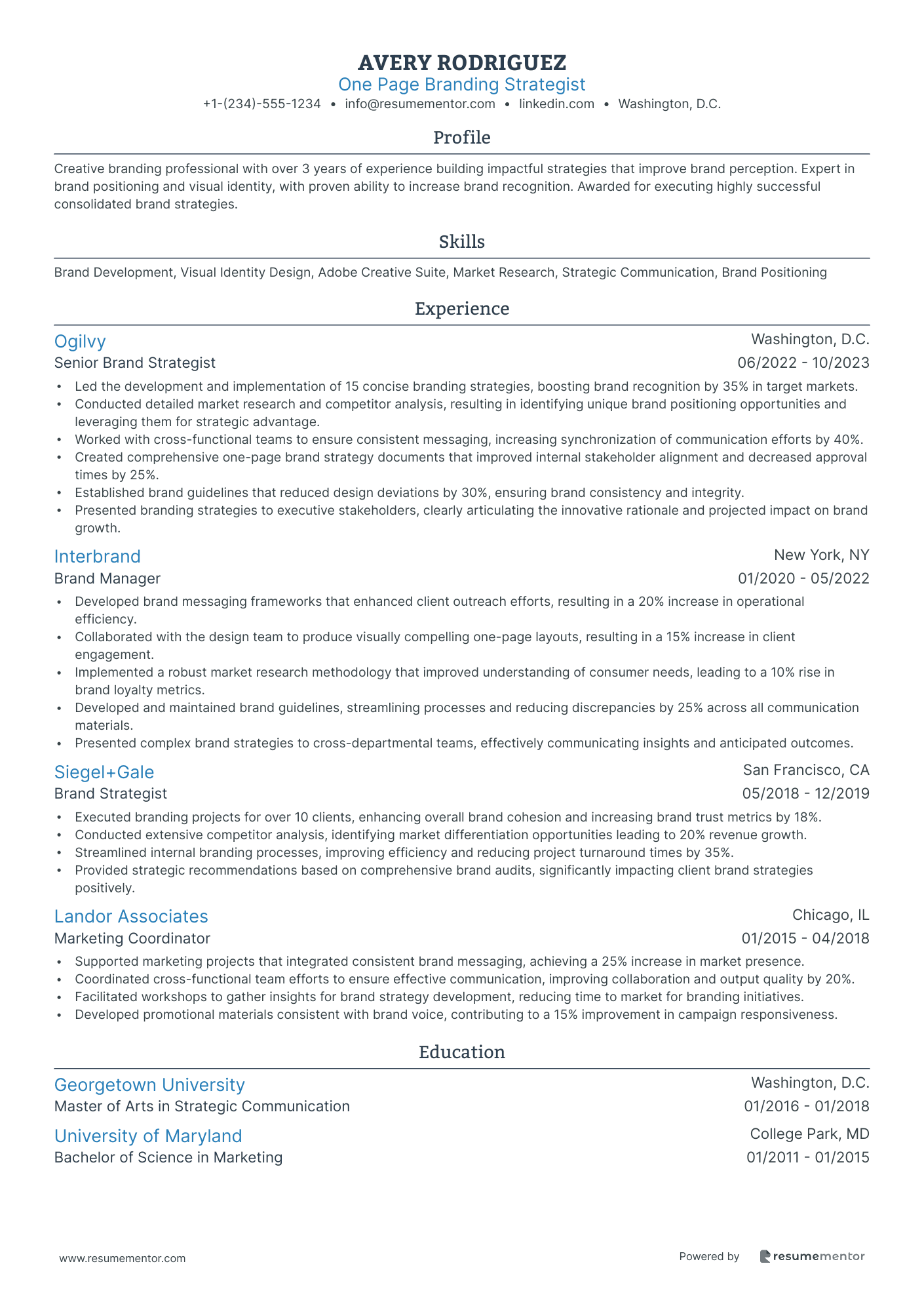
One Page Branding Strategist
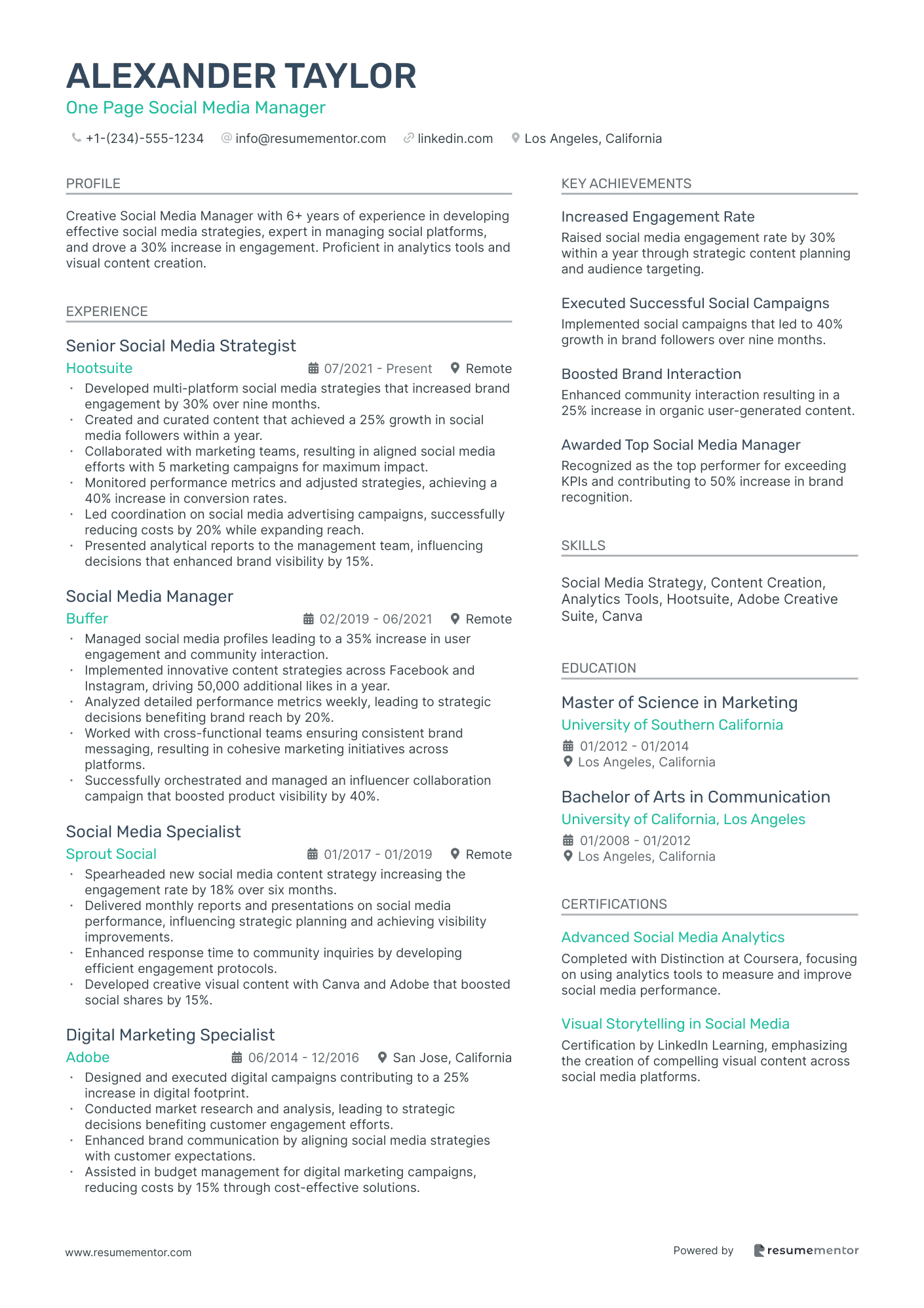
One Page Social Media Manager

One Page Creative Director resume sample
- •Led team of 12 creatives to execute a global campaign, resulting in a 20% increase in brand awareness.
- •Developed comprehensive brand guidelines, ensuring 95% consistency across digital platforms and printed materials.
- •Spearheaded a cross-functional team merging design and marketing, significantly enhancing customer engagement metrics by 30%.
- •Mentored junior designers, boosting their project contribution rate by 40% through personalized development plans.
- •Pioneered the introduction of AR in client campaigns, leading to a 15% increase in user interaction levels.
- •Facilitated stakeholder presentations, receiving accolades for turning complex ideas into approachable visual narratives.
- •Directed art and layout for multi-million dollar campaigns, achieving a 25% increase in market penetration.
- •Collaborated closely with marketing and UX teams, optimizing the customer journey and boosting engagement rates by 18%.
- •Orchestrated a brand refresh project, elevating brand perception and leading to a 10% boost in client acquisition.
- •Conducted workshops on emerging design trends, increasing team efficiency and creative output by 22%.
- •Managed resource allocation and project timelines, maintaining an on-time delivery rate of 98%.
- •Conceptualized and executed design strategies for client campaigns, achieving a 40% client retention rate.
- •Led a creative team in rebranding a major product line, which drove a 15% increase in sales within the first quarter.
- •Developed detailed creative briefs, ensuring project vision alignment and a 97% client approval rate on first submissions.
- •Initiated the use of user data analysis in ad campaigns, resulting in improved targeting and a 20% conversion increase.
- •Redesigned client websites, optimizing them for mobile platforms and realizing a 50% increase in mobile traffic.
- •Collaborated with marketing teams to create visually engaging content, leading to a 30% uptick in click-through rates.
- •Assisted in the development of interactive digital advertisements, which enhanced user experience and retention by 25%.
- •Participated in brainstorming sessions, contributing ideas that resulted in four successful national ad campaigns.
One Page Digital Content Specialist resume sample
- •Developed and optimized digital content, increasing audience engagement by 45% within 18 months.
- •Collaborated with cross-functional teams to execute content strategies, resulting in a 30% boost in brand visibility.
- •Implemented SEO best practices that improved search engine rankings by 35% over a two-year period.
- •Monitored and analyzed digital content performance, offering insights that enhanced retention by 20%.
- •Proofread and edited content for consistency and clarity, reducing errors by 70% and enhancing quality.
- •Managed a strategic content calendar, ensuring timely content release and alignment with marketing objectives.
- •Led content creation initiatives for digital platforms, increasing user engagement by 25%.
- •Worked closely with design and product teams to produce visually appealing content.
- •Conducted market research that informed content trends, elevating audience interaction by 20%.
- •Maintained consistent brand messaging across platforms, facilitating a 10% increase in brand loyalty.
- •Organized and prioritized content projects, ensuring all deadlines were met efficiently.
- •Developed SEO-driven content strategies, significantly increasing organic traffic by 50% over the tenure.
- •Collaborated with technical teams to improve metadata and keyword usage, enhancing discoverability.
- •Led a team of writers, achieving a 40% reduction in publication cycle time through streamlined processes.
- •Analyzed competitors’ content strategies to benchmark content performance and apply best practices.
- •Created engaging content for web and social media platforms, resulting in a 35% increase in audience reach.
- •Utilized analytics tools to measure content performance and applied insights to improve future projects.
- •Worked cross-functionally to integrate content with marketing strategies, supporting a 25% boost in campaign effectiveness.
- •Optimized existing content to enhance readability and user experience, improving session duration by 15%.
One Page SEO Strategist resume sample
- •Implemented comprehensive on-page SEO strategies, leading to a 30% increase in organic traffic within six months.
- •Conducted extensive keyword research, identifying high-value keywords that improved page rankings by 25%.
- •Reviewed and optimized metadata and headings for over 100 pages, resulting in a 15% increase in click-through rates.
- •Collaborated with content creators to enhance SEO value, leading to a 20% growth in user engagement.
- •Utilized Google Analytics and SEMrush to monitor performance, producing monthly reports to adjust strategies effectively.
- •Worked closely with the development team, improving technical SEO elements, optimizing site speed by 40%.
- •Developed SEO-friendly content strategies that increased search visibility by 35%, resulting in higher conversion rates.
- •Led competitive analysis, identifying opportunity areas and implementing changes that improved client satisfaction by 20%.
- •Optimized website images and alt texts, improving load times and boosting accessibility scores by 15%.
- •Engaged with cross-functional teams to ensure technical SEO best practices, aligning development projects with SEO goals.
- •Monitored Google Search Console data, identifying technical issues that were rectified to enhance site performance.
- •Performed site audits for over 50 websites, improving SEO scores across all pages, and increasing organic reach by 20%.
- •Recommended and implemented optimized URL structures, enhancing site navigation and reducing bounce rates by 10%.
- •Guided clients in aligning content strategies with their target audience, leading to a 25% increase in engagement.
- •Formulated metadata optimization plans, which led to a significant uplift in search engine ranking positions.
- •Implemented client-specific SEO plans that resulted in a 30% uplift in search engine visibility across target markets.
- •Exchanged knowledge with development teams to implement structured data where necessary, enhancing rich snippet visibility.
- •Continuous learning and adaptation to search engine algorithm updates, maintaining a proactive approach to SEO management.
- •Propelled user experience improvements, leading to increased time on site by nearly 25%.
One Page UX Designer resume sample
- •Led design projects for single-page applications, improving usability by 25% through enhanced user research methods and iterative feedback loops.
- •Collaborated with cross-functional teams to create wireframes and prototypes, speeding up development time by 15% and improving team efficiency.
- •Conducted comprehensive usability tests, leading to a 20% increase in user satisfaction through targeted design adjustments.
- •Authored and maintained detailed design documentation, aligning it with brand identity and accessibility standards, resulting in improved cross-team communication.
- •Introduced innovative solutions in design critique sessions, enhancing design quality and ensuring conformity with emerging UX/UI trends.
- •Streamlined the design feedback process with stakeholders, reducing iteration cycles by 10% and enhancing overall project timelines.
- •Developed wireframes and high-fidelity prototypes for online platforms, increasing user engagement metrics by 30% over one year.
- •Implemented solutions for enhancing brand consistency, resulting in a 50% improvement in site aesthetic ratings in user feedback.
- •Collaborated with developers to implement responsive design techniques, ensuring seamless UX across devices and reducing bounce rate by 12%.
- •Led cross-cultural user research sessions, synthesizing insights into actionable changes and enhancing multicultural interface accessibility by 17%.
- •Published a bi-monthly design trends newsletter, fostering team awareness and encouraging cutting-edge design approaches.
- •Crafted intuitive designs for desktop applications, boosting user retention by 22% through user-centric design frameworks.
- •Played a key role in integrating UX research into product redesigns, leading to a 35% increase in usability scores across customer reviews.
- •Partnered with product managers to align design goals with business objectives, increasing productivity by synchronizing efforts.
- •Analyzed user data in conjunction with engagement tools, resulting in impactful design decisions and improved interface navigation.
- •Designed engaging user interfaces for various digital products, resulting in a flagship app that received award-winning recognition.
- •Executed UX audits and redesigned web interfaces, contributing to a 40% reduction in user drop-off rates.
- •Collaborated with clients to translate their needs into tangible design outcomes, increasing client satisfaction scores by 20%.
- •Led workshops advocating for best practices and promoting innovative solutions to complex design challenges.
One Page PR Consultant resume sample
- •Led a team to develop an award-winning PR campaign that increased client media coverage by 50% within six months.
- •Crafted over 100 press releases and media alerts resulting in a 30% improvement in brand visibility across key markets.
- •Collaborated with cross-functional teams to align messaging, ensuring consistency across all platforms and achieving a brand recognition boost of 25%.
- •Conducted research to identify targeted media outlets, boosting PR engagement by tailoring strategies that resonated with each outlet.
- •Monitored media coverage and tracked KPIs, showcasing a 40% increase in positive media sentiment over a one-year period.
- •Utilized cutting-edge PR analytics software to provide actionable insights, leading to a 20% decrease in response time to media requests.
- •Developed concise one-page media alerts, increasing media engagement rates by 20% over a six-month span.
- •Organized PR campaigns that secured placements in leading publications, resulting in a 15% increase in client satisfaction scores.
- •Conducted comprehensive client interviews and gathered data to enhance PR materials, leading to more impactful communications.
- •Enhanced media relationship management processes, resulting in stronger journalist relations and a 10% rise in feature stories.
- •Supported the development of crisis communications strategies, which effectively mitigated risks and protected client reputations.
- •Executed multiple PR campaigns for diverse clients, resulting in a 25% boost in media placements across major outlets.
- •Developed and edited fact sheets and press releases that increased client engagement rates by 15%.
- •Coordinated with clients to refine key messages, ensuring accurate and compelling communication of their brand stories.
- •Contributed to a client project that saw a 30% increase in positive social media mentions within three months.
- •Assisted in developing targeted PR strategies that led to a 20% increase in client exposure and engagement.
- •Crafted engaging press materials that contributed to a successful campaign resulting in client sales growth by 10%.
- •Strengthened relationships with key media contacts, enhancing the success rate of story placements by 15%.
- •Managed multiple client accounts, ensuring projects were completed on time and exceeded client expectations.
One Page Copywriting Expert resume sample
- •Developed one-page promotional content for client campaigns, increasing engagement by 40% within three months.
- •Collaborated with marketing teams to align copy with strategic goals, resulting in a consistent brand voice across all assets.
- •Led a team project redesigning a landing page, boosting user conversions by 35% in Q3.
- •Streamlined content creation processes, reducing turnaround time by 20% while maintaining quality.
- •Conducted audience research, which enhanced message resonance and improved campaign efficiency by 50%.
- •Assessed analytics to refine content strategies and increased web traffic by 25% over six months.
- •Authored compelling copy for brochures and digital ads, heightening brand awareness by 30%.
- •Engaged in cross-departmental teams to integrate cohesive messaging and visual design.
- •Revised marketing content to enhance clarity, ensuring grammatical accuracy and uniformity.
- •Utilized SEO principles in web content, leading to a 15% increase in organic search rankings.
- •Proposed content performance improvements, resulting in a 10% increase in customer acquisition through digital channels.
- •Designed one-page flyers, significantly boosting event attendance and customer interest.
- •Executed comprehensive research on consumer behavior, tailoring content to audience preferences.
- •Partnered with product teams to deliver clear & persuasive product descriptions, increasing sales by 20%.
- •Monitored content performance metrics, refining approaches that yielded a 25% engagement uplift.
- •Crafted innovative and persuasive one-page sales copy, enhancing client retention by 15%.
- •Assessed competitor copy offerings to propose unique client strategies, augmenting advertising impact.
- •Cultivated brand-aligned taglines and slogans, strengthening market positioning and brand recall.
- •Facilitated content workshops, educating marketers on effective storytelling techniques.
One Page Visual Designer resume sample
- •Led a team of designers to create one-page visuals, increasing consumer engagement by 30% in a year.
- •Developed innovative layout concepts for product pages, resulting in a 25% improvement in conversion rates.
- •Collaborated with product teams to refine prototypes, ensuring alignment with brand and user experiences.
- •Translated complex product functionalities into engaging and easy-to-understand design narratives.
- •Streamlined design workflows and processes, cutting project delivery times by 20% across multiple teams.
- •Used design trends to produce graphics that elevated brand perception and drove a 15% sales increase.
- •Created over 100 one-page designs that maintained brand consistency across various media platforms.
- •Designed user-friendly layout structures, improving the ease of navigation and reducing bounce rates by 10%.
- •Actively participated in cross-functional team brainstorming, enhancing project scope and creative solutions.
- •Advanced the company’s style guide, leading to a 15% reduction in inconsistencies in visual assets.
- •Utilized Adobe InDesign for high-quality design output, delivering assets that exceeded quality standards.
- •Executed branding projects resulting in a 40% increase in viewer recognition and appreciation.
- •Revised and optimized typography, enhancing readability and aesthetic appeal of marketing materials.
- •Converted complex information into visually coherent designs, earning positive media reviews.
- •Worked collaboratively in a fast-paced environment to produce high-quality graphics efficiently.
- •Supported senior designers in producing captivating visuals for online game releases.
- •Managed small scale projects independently, increasing my responsibility and showcasing project success.
- •Assisted in the preparation of final design assets, ensuring high standards of quality were maintained.
- •Engaged with design teams to incorporate feedback, enhancing the learning and creative process.
One Page Marketing Coordinator resume sample
- •Developed one-page marketing materials that increased product interest by 20% in targeted demographics.
- •Collaborated with a cross-functional team to produce engaging content for social media, resulting in a 15% increase in followers.
- •Conducted market research leading to a successful new campaign strategy that boosted brand awareness by 25%.
- •Assisted in organizing marketing events, driving a 30% uptick in attendance through effective promotional efforts.
- •Monitored campaign performance using analytics tools, leading to a 18% improvement in email open rates through recommended adjustments.
- •Coordinated with graphic designers to produce visually appealing marketing materials, enhancing customer retention by 10%.
- •Managed email marketing campaigns that resulted in a 10% increase in customer engagement metrics.
- •Created and implemented social media strategies that improved follower interaction by 40% across multiple platforms.
- •Conducted A/B testing on campaign materials, optimizing user engagement rates by 15%.
- •Assisted with planning and executing a marketing conference, achieving a 20% increase in sponsor participation.
- •Coordinated with various teams to ensure timely delivery of marketing projects, resulting in a 99% on-time completion rate.
- •Designed marketing collateral that enhanced product visibility and improved sales by 12% in targeted regions.
- •Supported social media management, increasing brand followers by 18% over a period of 6 months.
- •Conducted market research to identify consumer trends, leading to a 15% improvement in targeting accuracy.
- •Collaborated with designers to create advertising materials that resulted in a 20% increase in online inquiries.
- •Developed and maintained engaging content for company blog, growing readership by 25% over 9 months.
- •Implemented SEO strategies to improve search ranking, achieving a 10% increase in organic traffic.
- •Coordinated content calendar that ensured timely publication of materials, resulting in a 99% adherence rate.
- •Assisted with planning of promotional activities that led to a 15% increase in consumer engagement.
One Page Branding Strategist resume sample
- •Led the development and implementation of 15 concise branding strategies, boosting brand recognition by 35% in target markets.
- •Conducted detailed market research and competitor analysis, resulting in identifying unique brand positioning opportunities and leveraging them for strategic advantage.
- •Worked with cross-functional teams to ensure consistent messaging, increasing synchronization of communication efforts by 40%.
- •Created comprehensive one-page brand strategy documents that improved internal stakeholder alignment and decreased approval times by 25%.
- •Established brand guidelines that reduced design deviations by 30%, ensuring brand consistency and integrity.
- •Presented branding strategies to executive stakeholders, clearly articulating the innovative rationale and projected impact on brand growth.
- •Developed brand messaging frameworks that enhanced client outreach efforts, resulting in a 20% increase in operational efficiency.
- •Collaborated with the design team to produce visually compelling one-page layouts, resulting in a 15% increase in client engagement.
- •Implemented a robust market research methodology that improved understanding of consumer needs, leading to a 10% rise in brand loyalty metrics.
- •Developed and maintained brand guidelines, streamlining processes and reducing discrepancies by 25% across all communication materials.
- •Presented complex brand strategies to cross-departmental teams, effectively communicating insights and anticipated outcomes.
- •Executed branding projects for over 10 clients, enhancing overall brand cohesion and increasing brand trust metrics by 18%.
- •Conducted extensive competitor analysis, identifying market differentiation opportunities leading to 20% revenue growth.
- •Streamlined internal branding processes, improving efficiency and reducing project turnaround times by 35%.
- •Provided strategic recommendations based on comprehensive brand audits, significantly impacting client brand strategies positively.
- •Supported marketing projects that integrated consistent brand messaging, achieving a 25% increase in market presence.
- •Coordinated cross-functional team efforts to ensure effective communication, improving collaboration and output quality by 20%.
- •Facilitated workshops to gather insights for brand strategy development, reducing time to market for branding initiatives.
- •Developed promotional materials consistent with brand voice, contributing to a 15% improvement in campaign responsiveness.
One Page Social Media Manager resume sample
- •Developed multi-platform social media strategies that increased brand engagement by 30% over nine months.
- •Created and curated content that achieved a 25% growth in social media followers within a year.
- •Collaborated with marketing teams, resulting in aligned social media efforts with 5 marketing campaigns for maximum impact.
- •Monitored performance metrics and adjusted strategies, achieving a 40% increase in conversion rates.
- •Led coordination on social media advertising campaigns, successfully reducing costs by 20% while expanding reach.
- •Presented analytical reports to the management team, influencing decisions that enhanced brand visibility by 15%.
- •Managed social media profiles leading to a 35% increase in user engagement and community interaction.
- •Implemented innovative content strategies across Facebook and Instagram, driving 50,000 additional likes in a year.
- •Analyzed detailed performance metrics weekly, leading to strategic decisions benefiting brand reach by 20%.
- •Worked with cross-functional teams ensuring consistent brand messaging, resulting in cohesive marketing initiatives across platforms.
- •Successfully orchestrated and managed an influencer collaboration campaign that boosted product visibility by 40%.
- •Spearheaded new social media content strategy increasing the engagement rate by 18% over six months.
- •Delivered monthly reports and presentations on social media performance, influencing strategic planning and achieving visibility improvements.
- •Enhanced response time to community inquiries by developing efficient engagement protocols.
- •Developed creative visual content with Canva and Adobe that boosted social shares by 15%.
- •Designed and executed digital campaigns contributing to a 25% increase in digital footprint.
- •Conducted market research and analysis, leading to strategic decisions benefiting customer engagement efforts.
- •Enhanced brand communication by aligning social media strategies with customer expectations.
- •Assisted in budget management for digital marketing campaigns, reducing costs by 15% through cost-effective solutions.
Crafting a resume can feel like assembling a complex puzzle, especially when fitting your one-page experience into traditional formats. As a one-page professional, you bring unique skills and talents to the table, but translating these onto a single sheet can be tough. Achieving the right balance between showcasing your qualifications and maintaining a concise format requires careful consideration.
Understanding the challenges you face is the first step in overcoming them. When it comes to choosing the right words or presenting your abilities effectively, every detail matters. Your resume should not only outline your work history but also highlight your strengths in a way that captures a hiring manager’s attention.
This is where a professional resume template comes in handy. By providing a structured layout, templates help you organize your career path logically and efficiently. This makes it easier to clearly convey your technical expertise and personal qualities. For options tailored to your needs, consider exploring these resume templates.
Think of your resume as your personal marketing tool, designed to tell your unique story in a compact form. With careful planning and the right resources, you’re well-equipped to create a resume that truly reflects your one-page essence and makes a strong impression.
Key Takeaways
- Creating a one-page teacher resume involves balancing concise format and comprehensive content to capture hiring managers' attention.
- A structured template can help organize career paths logically, making it easier to convey technical expertise and personal qualities effectively.
- Tailor the resume format according to the industry; creative roles benefit from modern layouts while traditional fields prefer organized, professional formats.
- Highlight core achievements and key skills, ensuring they align with the specific job's requirements to stand out to employers and Applicant Tracking Systems (ATS).
- Include relevant education, certificates, and additional sections like language skills and volunteer work to provide a holistic view, enhancing your resume's appeal.
What to focus on when writing your one page resume
Your one-page resume should clearly convey your professional value and qualifications, emphasizing why you're the best fit for the job. This compact format allows you to highlight your core achievements and strengths, tailoring them to fit the specific role you're targeting.
How to structure your one page resume
- Contact Information: Begin with your name, phone number, email, and LinkedIn profile if applicable. Clear and current contact details make sure recruiters can easily reach you—accuracy here ensures you don't miss important connections.
- Professional Summary: Offer a quick snapshot of your top skills and major achievements related to the position. This overview should align with both your career goals and the unique traits that resonate with the employer's needs, setting the stage for your work experience.
- Work Experience: Follow with your job titles, company names, and dates of employment. Using bullet points, detail key responsibilities and achievements that demonstrate abilities like "project management" or other relevant skills—choose examples that directly link to the job's requirements.
- Education: Next, list your degrees, schools, and graduation dates. Mention any honors or projects that display relevant skills, such as an "engineering design project" for those pursuing technical fields—this bridges into showcasing specialized skills.
- Skills: Finally, highlight the critical skills needed for the job. Detailed specifics like "medical expertise" for healthcare roles or "coding proficiency" for tech positions should be emphasized—this ensures clarity on your ability to fulfill role-specific demands.
We’ve now overviewed how to write a targeted [job title] resume. Below, we'll delve deeper into each section, offering more insight on how to effectively present your qualifications for the specific job you're seeking.
Which resume format to choose
Crafting a one-page resume for your specific job title involves focusing on key elements that highlight your skills and experience. Choosing the right format is essential; it should reflect both your industry and experience level. For creative roles, a modern and eye-catching layout can make you memorable, while traditional fields like finance or law benefit from a straightforward, neatly organized format that conveys professionalism and competence.
Your choice of font can also subtly influence how your resume is perceived. Opt for modern and clean fonts like Montserrat, Lato, or Raleway. These typefaces enhance readability and lend a contemporary feel to your resume, helping it stand out in a sea of standard resumes. Keep the font size between 10 and 12 points for optimal readability, with headings slightly larger to guide the eye smoothly through your document.
When it comes to file types, always save your resume as a PDF. This format ensures that your document's layout remains exactly as you've designed it, regardless of the device or software used by hiring managers. PDFs provide a polished and professional appearance, which is crucial when you want your resume to make a strong initial impression.
Don’t overlook the significance of margins. Setting them to about one inch on all sides creates the right amount of white space, keeping your resume looking clean and uncluttered. This strategic use of space enhances readability, allowing recruiters to quickly and easily find the most important information.
Finally, ensure every component of your resume has a clear purpose, showcasing your qualifications and achievements effectively. By focusing on clarity and precision, you build a document that authentically represents your professional capabilities. These thoughtful details ensure that your one-page resume captures the attention of employers and resonates within your industry.
How to write a quantifiable resume experience section
A strong one-page resume experience section is essential for making a positive impression on hiring managers. This section should weave your work history into a story that highlights your fit for the desired job. Start with your most recent role and organize your experience in reverse chronological order. By focusing on your major accomplishments and responsibilities, you align your history with the position you’re targeting. It's best to keep the details to the last 10 to 15 years, spotlighting roles that align with your current career goals and showcasing job titles that reflect your growth.
Tailoring your resume to the job ad is vital for making each word count. Incorporating specific terms and phrases from the ad emphasizes your relevant skills and achievements. Selecting strong action words like “achieved,” “improved,” “led,” and “developed” showcases your impact and leadership qualities. Make sure to quantify these accomplishments to clearly demonstrate your success. When you effectively tailor this section, it captures attention and clearly communicates your value to potential employers.
- •Increased social media engagement by 35% through creative campaigns and A/B testing.
- •Boosted online sales by 20% year-over-year by optimizing content marketing strategies.
- •Led a team of 8 to successfully launch 3 major product lines, resulting in $5M in revenue.
- •Developed customer loyalty program that increased repeat purchases by 25%.
The experience section above is effective because it clearly connects your achievements to significant business outcomes. Each bullet not only quantifies your accomplishments but also uses strong verbs to convey your leadership and drive. By structuring your experience in this format, it immediately demonstrates your ability to achieve growth and results, precisely matching the employer’s needs. This concise yet powerful presentation grabs attention quickly, making sure your accomplishments shine.
Training and Development Focused resume experience section
A Training and Development-focused resume experience section should clearly showcase your achievements and responsibilities in a seamless narrative. Begin by listing your jobs starting with the most recent, noting the dates of employment, your job title, and the company's name. Follow this with bullet points that highlight your accomplishments and contributions, emphasizing your training and development expertise. Use action-oriented language to demonstrate the tangible impact you had in each position, ensuring that your descriptions are both concise and clear to quickly convey your proficiency to hiring managers.
Each bullet point should illustrate a different aspect of your training skills, creating a comprehensive picture of your abilities. Highlight innovative programs you developed, your role in boosting employee performance, and any recognition you earned along the way. This section serves as your opportunity to connect the dots between your skills and their real-world application, showing how you benefited past employers. By focusing on measurable outcomes and significant impacts, your experience section will effectively highlight your value, making it an integral part of your resume.
Senior Training Specialist
Tech Innovators Inc.
January 2020 - Present
- Led the creation of interactive employee training modules, increasing engagement by 35%.
- Implemented a mentorship program that improved new employee retention rates by 20%.
- Partnered with department heads to tailor training sessions, aligning with company goals.
- Received a 'Trainer of the Year' award for excellence in employee development initiatives.
Project-Focused resume experience section
A project-focused resume experience section should clearly highlight the key projects that showcase your expertise and impact. Begin by identifying the area of your experience, such as "Web Development" or "Project Management," which quickly informs the reader of your specialty. Follow up with a description of your role and the specific responsibilities you held in each project, ensuring you convey the significance of your contributions. By prioritizing detailed yet concise descriptions, you help your audience grasp the depth of your involvement.
Furthermore, quantifying your achievements with numbers and percentages, such as "boosted efficiency by 20%" or "managed a 10-person team," adds weight and clarity to your claims, making them more compelling and tangible. Write simply and clearly to keep your information approachable for different readers, avoiding complex jargon. Finally, organize your accomplishments under distinct headings so potential employers or clients can easily find the essential information they need.
Lead Developer
Tech Solutions Inc.
June 2022 - September 2023
- Led a team of 5 developers to successfully launch a dynamic e-commerce website.
- Implemented SEO best practices, increasing site traffic by 30% over four months.
- Collaborated with cross-functional teams to ensure project deliverables were met on time.
- Optimized website performance, resulting in a 40% reduction in load times.
Industry-Specific Focus resume experience section
A focus-focused resume experience section should begin by clearly defining your specialization within the industry you're aiming for. Tailor your content to highlight the skills and achievements most relevant to the job at hand. By concentrating on experiences that showcase your strengths, like project management or technical expertise, you create a vivid picture of your capabilities. It's important to use straightforward language when describing your roles, as this helps underline the measurable outcomes or improvements you've achieved, always aligning them with industry expectations.
To create a seamless flow in your experience section, list your work history starting with your most recent role. Begin with the job title, then the workplace, followed by the dates of employment. In your bullet points, emphasize how you made an impact. Each statement should clearly articulate your achievements and the differences you made. Rather than simply listing duties, focus on the tangible changes or improvements you brought, the issues you resolved, and how you contributed to the company’s success.
Senior Project Manager
Tech Innovations Inc
June 2020 - August 2023
- Led a team of 10 in rolling out a new software platform, boosting system efficiency by 30%.
- Implemented solutions that cut errors in customer data entry by 25%.
- Trained and mentored five junior engineers, encouraging a team-centered and growth-focused environment.
- Coordinated with cross-functional teams to deliver projects 15% under budget and ahead of schedule.
Achievement-Focused resume experience section
A resume experience section for a marketing-focused digital marketing specialist should clearly showcase the impact you've made in your roles. Begin by stating your job title, employment dates, and the company's name. Use bullet points to detail your achievements, emphasizing the results and skills involved. Whenever possible, quantify your success with numbers or metrics to highlight your contributions. This strategy helps potential employers quickly recognize the value you offer.
Craft your bullet points using strong action verbs, such as "improved," "generated," or "led," to effectively communicate your accomplishments. Concentrate on achievements rather than tasks to distinguish yourself from others with similar backgrounds. Tailor each point to the job you're applying for, prioritizing the most relevant experiences. Keep your language straightforward and precise so anyone can easily grasp your achievements at a glance. This approach makes your resume stand out and demonstrates your clear communication skills.
Digital Marketing Specialist
Star Tech Innovations
June 2021 - Present
- Increased social media engagement by 45% through innovative content strategies.
- Led a team in launching a product campaign that resulted in a 30% sales increase.
- Generated over 200 qualified leads per month using targeted email marketing.
- Implemented data-driven approaches to reduce customer acquisition costs by 20%.
Write your one page resume summary section
A marketing-focused resume experience section should capture the essence of what makes you an invaluable candidate. A strong resume summary can be the key to capturing a potential employer's attention. It's important because it offers a snapshot of your most relevant skills and experiences tailored to the job you're aiming for. As you write, think about what makes you unique for the role and how you can stand out. Use simple, clear language and aim for three to five concise sentences. Focus on career goals that align with the position to show employers you're a great fit. Each part should reflect what the employer values in a candidate. Those with considerable experience might opt for a summary, while newcomers might use a resume objective to highlight enthusiasm and aspirations.
This example stands out due to its clear quantification of achievements and relevant skill showcase, illustrating capabilities with concrete results. The language is straightforward, ensuring quick readability. Many confuse a summary with an objective, profile, or summary of qualifications. An objective clarifies what you're seeking in a job, a profile describes your personality and working style, and a summary of qualifications highlights your top skills in bullet points. Regardless of your experience level, a well-crafted resume summary or objective can effectively communicate your professional value, setting you apart in a competitive job market.
Listing your one page skills on your resume
A skills-focused resume is key to effectively showcasing your abilities to potential employers. When drafting your one-page resume, you have the option to feature a dedicated skills section or weave your skills into sections like your experience and summary. Presenting a standalone section can clearly highlight your strengths, such as soft skills like teamwork and communication, which enhance collaboration. On the other hand, hard skills—like programming and data analysis—are specific abilities that are teachable and measurable.
These skills and strengths double as resume keywords, which are crucial for capturing the attention of employers and Applicant Tracking Systems (ATS) searching for specific competencies. It's important to ensure these keywords align with the job you're targeting, making your application more relevant.
Example of a standalone skills section:
The effectiveness of this example lies in its clarity and conciseness, featuring a list of relevant skills without overwhelming the reader. Highlighting eight skills offers breadth while remaining focused. Presenting the information in JSON format reflects a current and tech-savvy approach that can appeal to digital-minded employers.
Best hard skills to feature on your one-page resume
Choosing the right hard skills for your resume is vital for demonstrating your technical expertise and specific know-how. These skills communicate your ability to perform essential tasks and vary by industry, significantly enhancing your employability.
Hard Skills
- Data Analysis
- Programming Languages (e.g., Python, Java)
- Project Management
- Search Engine Optimization (SEO)
- Financial Modeling
- Graphic Design
- Cloud Computing
- UX/UI Design
- Database Management
- Cybersecurity
- Quality Assurance
- Machine Learning
- Technical Writing
- Digital Marketing
- Network Administration
Best soft skills to feature on your one-page resume
Equally important are soft skills, which show how you interact and collaborate with others, indicating your capability to work effectively in a team and adapt to various environments.
Soft Skills
- Communication
- Problem Solving
- Adaptability
- Teamwork
- Time Management
- Emotional Intelligence
- Leadership
- Creativity
- Conflict Resolution
- Critical Thinking
- Work Ethic
- Decision Making
- Networking
- Positivity
- Attention to Detail
How to include your education on your resume
An education section is a crucial part of your resume. It showcases your academic background and provides evidence of your qualifications. A well-crafted education section captures the attention of potential employers and demonstrates that you have the necessary academic credentials for the job. When writing your education section, focus only on the education relevant to the job you're applying for. Irrelevant education should be left out to keep the resume concise and focused. Including your GPA is optional, but if it's above 3.5, it can highlight your academic achievements. Similarly, mention honors like cum laude if applicable, as they indicate academic excellence. Always list your degree accurately, using the full name, and include the institution's name and location. Including dates helps to provide context and establish a timeline.
Here's an example of a poorly done education section:
Here's an example of an effective education section:
- •Graduated cum laude
The second example is effective because it directly relates to a tech position, likely sought after by someone with a computer science degree. It includes a high GPA and mentions graduating cum laude, showcasing academic dedication. The dates are clearly displayed, helping to build a clear picture of the candidate's timeline. This section is concise and relevant, making it easy for employers to see the applicant's qualifications at a glance.
How to include one page certificates on your resume
In a resume, the certificates section can play a critical role by showcasing your relevant qualifications. List the name of each certificate clearly. Include the date you received the certificate to provide a timeline of your professional development. Add the issuing organization to give credibility and context to your certification. This section provides a concrete measure of your skills and commitment to your professional growth. Including certificates in the header is another option, allowing them to stand out prominently. For example, you could write, "Certified ScrumMaster, Scrum Alliance, 2022" next to your name and contact information.
A good example of a standalone certificates section for a software project manager includes certifications directly related to the field. For instance, listing a "Project Management Professional (PMP)," issued by the Project Management Institute, immediately signals expertise. Another valuable certification is the "Certified ScrumMaster," which shows familiarity with agile methodologies. The importance of these certificates is underscored when working on projects that employ agile practices. Relevant certifications reflect an understanding of field-specific processes and solutions, making you an attractive candidate.
This example is good because it includes recognized and respected certifications in the project management industry. Each certificate listed is highly relevant, with issuing organizations that are well-known and credible.
Extra sections to include on your one page resume
Crafting a resume often feels daunting, but focusing on the right sections can showcase your strengths and individuality. Including sections such as language skills, hobbies, volunteer work, and books can give employers a fuller picture of you beyond work experience and education. Here's how they each add value to your resume.
Languages — Highlighting language abilities shows you’re capable of working in diverse environments and can communicate with wider audiences. Indicating proficiency levels—like fluent or conversational—gives a clear understanding of your communication skills.
Hobbies and interests — Sharing hobbies or interests can make you more relatable and show employers that you have a balanced life. This section can also highlight attributes like creativity, teamwork, or passion.
Volunteer work — Listing volunteer experiences demonstrates your commitment to community and willingness to go beyond yourself. This section can often highlight skills like leadership, organization, or problem-solving.
Books — Mentioning books you’ve read shows your willingness to learn and grow intellectually. It also opens up potential talking points for interviews and can demonstrate your interests aligning with industry trends.
Each of these sections enhances your resume by providing a more holistic view of who you are as an individual, beyond your professional qualifications. Integrating them thoughtfully ensures you stand out to potential employers and show dimension beyond technical skills.
In Conclusion
In conclusion, a one-page resume is not just a document but a strategic tool that encapsulates your professional journey succinctly and effectively. Crafting such a resume requires you to prioritize and streamline your experiences, skills, and achievements to fit within a single page without losing the essence of your uniqueness. By leveraging professional templates, you can present your information in an organized and appealing manner, ensuring all details are clear and compelling. Remember, the format you choose should reflect the industry standards while allowing your personal touch and creativity to come through. Utilizing modern fonts and optimal file formats, like PDFs, can enhance the overall readability and presentation of your resume. When constructing sections such as your work experience, skills, and education, focusing on quantifiable achievements and relevant keywords tailored to the job description is crucial. Moreover, don’t overlook the potential of extra sections like languages, hobbies, and volunteer work, as they can provide depth to your profile by showing a broader spectrum of your capabilities and personality. Ultimately, a well-organized one-page resume can significantly boost your chances of making a lasting impression, effectively communicating your value, and setting the stage for future conversations with potential employers.
Related Articles
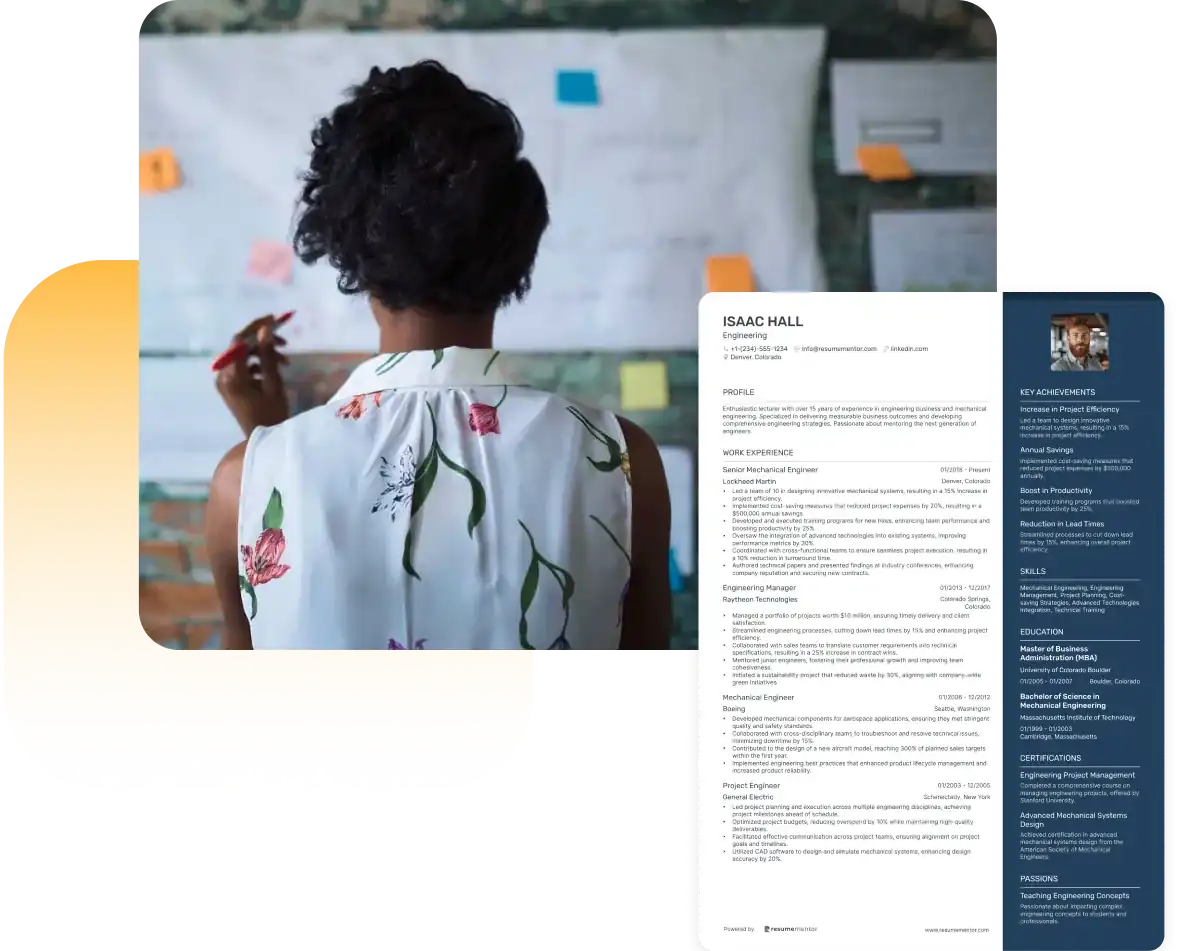
Continue Reading
Check more recommended readings to get the job of your dreams.
Resume
Resources
Tools
© 2025. All rights reserved.
Made with love by people who care.

